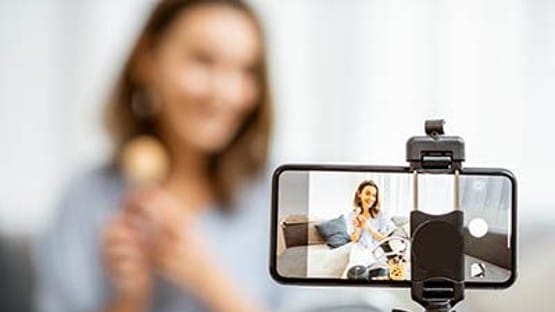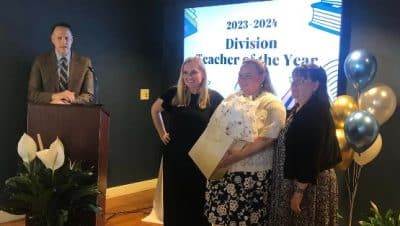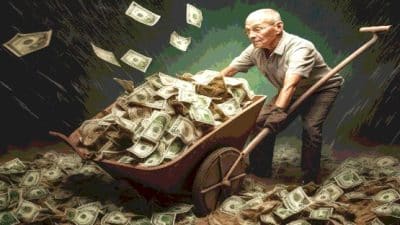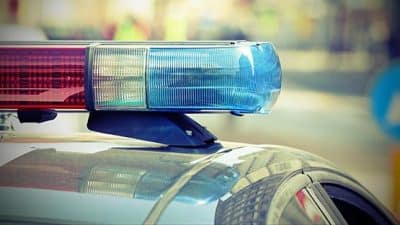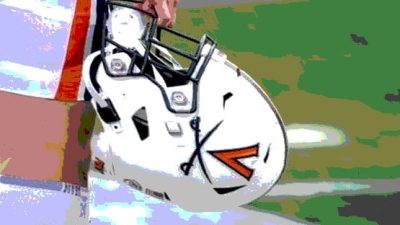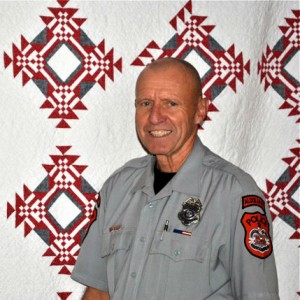
One by one, each floor of the antebellum house was searched by law enforcement.
“There was no question in our minds that someone would try to steal quilts,” said Auxiliary Officer Thurston Bechtel of Harrisonburg’s police department. After all, three of the quilts on display in the museum were his.
Bechtel worked the scene with his son, a member of the city’s police force. Not just once, but four times that night the alarm system went off. It apparently had a faulty sensor. Bechtel, a Vietnam Veteran and retired Los Angeles Police Department officer, is one of 18 men and young men who have quilts in the museum’s exhibit entitled men WHO QUILT. “We know quilts are valuable,” said Bechtel, “I wasn’t just thinking of my work.”
Like other male quilters featured in the exhibit, Bechtel is not the stereotypical quilter. He started quilting in 1994 while he was a stay-at-home Dad, enabling his wife to pursue her studies in molecular biology at the University of Southern California. To learn to repair clothing for his seven-year-old son, he took a class in quilt making, the only sewing course he could find. He realize that he enjoyed the orderly progression of sewing quilt patterns, and being able to manipulate designs and colors. It became his hobby and stress reliever.
Most of Bechtel’s quilts are traditional designs and are bed size. He intends for his quilts to be useful, and has made more than 120 to date, giving many as gifts. His favorite colors are red and black. Two of his quilts in the museum exhibit are made with those colors. To choose a pattern for his quilts, he often sees a picture of a design he likes and measures the dimensions using a dollar bill, which is exactly 6” long. He holds the paper money up to the design and calculates how it will work with fabric yardage.
Now a member of the Shenandoah Valley Quilters Guild, he also belonged to a guild when he lived in California. “I learn from other quilt makers,” he said. But he knows what he wants when it comes to fabrics, and he buys fabrics to have on hand because he has more than one quilt in process at a time.
Although Bechtel and his family moved to Harrisonburg in 2006, he keeps contact with the Los Angeles Police Department by donating a quilt each year to the Jack Webb Awards Banquet, a fund raiser for the Los Angeles Police Museum.
A special event related to the men WHO QUILT exhibit will be a lecture on Oct. 25 by well-known quilt maker Jonathan Gregory, Assistant Curator of Exhibitions at the International Quilt Study Center & Museum in Lincoln, NE. Gregory will discuss his views on how gender impacts quilts. “Men quilt for many of the same reasons that women do, except they may find it easier to depart from tradition,” according to Gregory. Based on his experience, Thurston Bechtel agrees.
men WHO QUILT will be on display at the Virginia Quilt Museum through Dec. 20, 2014. Tickets for the Jonathan Gregory lecture and reception are $25 for members, and $30 for non-members. The lecture will start at 1:30 pm in Showker Hall, First Presbyterian Church, Harrisonburg. Tickets may be purchased by calling the museum at 540-433-3818 or online atwww.vaquiltmuseum.org/special-events/special-events/
The Virginia Quilt Museum was founded in 1995 and exists to celebrate quilting in Virginia. The Museum is a 501(c)(3) non-profit funded solely through private donations, membership, and revenue from admissions and museum shop sales. The Museum receives no federal or state funding.



